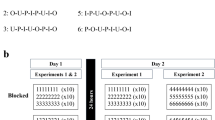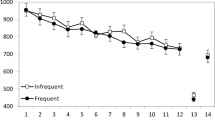Abstract
Implicit learning and transfer in sequence acquisition play important roles in daily life. Several previous studies have found that even when participants are not aware that a transfer sequence has been transformed from the learning sequence, they are able to perform the transfer sequence faster and more accurately; this suggests implicit transfer of visuomotor sequences. Here, we investigated whether implicit transfer could be modulated by the number of trials completed in a learning session. Participants learned a sequence through trial and error, known as the m × n task (Hikosaka et al. in J Neurophysiol 74:1652–1661, 1995). In the learning session, participants were required to successfully perform the same sequence 4, 12, 16, or 20 times. In the transfer session, participants then learned one of two other sequences: one where the button configuration Vertically Mirrored the learning sequence, or a randomly generated sequence. Our results show that even when participants did not notice the alternation rule (i.e., vertical mirroring), their total working time was less and their total number of errors was lower in the transfer session compared with those who performed a Random sequence, irrespective of the number of trials completed in the learning session. This result suggests that implicit transfer likely occurs even over a shorter learning duration.




Similar content being viewed by others
Notes
Note that Tanaka and Watanabe (2014a) found faster standardized performances in the Unaware group than in the Random group. This might be due to the fact that in the previous study we were able to take into account the within-participant standard deviation by dividing transfer performance by learning performance, while in the present study we could not do so because of the modulation of successful trials in the learning session. Thus, further investigations, for example, by utilizing a baseline 3 × 7 task with equal successful trials before running the present learning session in order to calculate standardized performances, are warranted.
References
Abrahamse EL, Jiménez L, Verwey WB, Clegg BA (2010) Representing serial action and perception. Psychon Bull Rev 17:603–623
Abrahamse EL, Ruitenberg MF, De Kleine E, Verwey WB (2013) Control of automated behavior: insights from the discrete sequence production task. Front Hum Neurosci 7:1–16
Ashby FG, Alfonso-Reese L, Turken A, Waldron E (1998) A neuropsychological theory of multiple-systems in category learning. Psychol Rev 105:442–481
Bapi RS, Doya K, Harner AM (2000) Evidence for effector independent and dependent representations and their differential time course of acquisition during motor sequence learning. Exp Brain Res 132:149–162
Bapi RS, Miyapuram KP, Graydon FX, Doya K (2006) fMRI investigation of cortical and subcortical networks in the learning of abstract and effector-specific representations of motor sequences. Neuroimage 32:714–727
Bo J, Seidler RD (2009) Visuospatial working memory capacity predicts the organization of acquired explicit motor sequences. J Neurophysiol 101:3116–3125
Dienes Z, Longuet-Higgins HC (2004) Can musical transformations be implicitly learned? Cogn Sci 28:531–558
Dienes Z, Kuhn G, Guo XY, Jones C (2012) Communicating structure, affect and movement: commentary on Bharucha, Curtis and Paroo. In: Rebuschat P, Rohrmeier M, Cross I, Hawkins J (eds) Language and music as cognitive systems. Oxford University Press, Oxford, pp 156–168
Hikosaka O, Rand MK, Miyachi S, Miyashita K (1995) Learning of sequential movements in the monkey: process of learning and retention of memory. J Neurophysiol 74:1652–1661
Hikosaka O, Sakai K, Miyauchi S, Takino R, Sasaki Y, Putz B (1996) Activation of human presupplementary motor area in learning of sequential procedures: a functional MRI study. J Neurophysiol 76:617–621
Hikosaka O, Nakahara H, Rand MK, Sakai K, Lu X, Nakamura K, Miyachi S et al (1999) Parallel neural networks for learning sequential procedures. Trends Neurosci 22:464–471
Hikosaka O, Nakamura K, Sakai K, Nakahara H (2002) Central mechanisms of motor skill learning. Curr Opin Neurobiol 12:217–222
Kuhn G, Dienes Z (2005) Implicit learning of non-local musical rules: implicitly learning more than chunks. J Exp Psychol Learn 31:1417–1432
Li F, Jiang S, Guo X, Yang Z, Dienes Z (2013) The nature of the memory buffer in implicit learning: learning Chinese tonal symmetries. Conscious Cognit 22:920–930
Nissen MJ, Bullemer P (1987) Attentional requirements of learning: evidence from performance measures. Cogn Psychol 19:1–32
Perruchet P, Pacton S (2006) Implicit learning and statistical learning: one phenomenon, two approaches. Trends Cogn Sci 10:233–238
Pothos EM (2007) Theories of artificial grammar learning. Psychol Bull 133:227–244
Rand MK, Hikosaka O, Miyachi S, Lu X, Nakamura K, Kitaguchi K, Shimo Y (2000) Characteristics of sequential movements during early learning period in monkeys. Exp Brain Res 131:293–304
Reber AS (1967) Implicit learning of artificial grammars. JVLVB 6:317–327
Sakai K, Hikosaka O, Miyachi S, Takino R, Sasaki Y, Putz B (1998) Transition of brain activation from frontal to parietal areas in visuomotor sequence learning. J Neurosci 18:1827–1840
Sakai K, Kitaguchi K, Hikosaka O (2003) Chunking during human visuomotor learning. Exp Brain Res 152:229–242
Sakai K, Hikosaka O, Nakamura K (2004) Emergence of rhythm during motor learning. Trends Cogn Sci 8:547–553
Tanaka K, Watanabe K (2013) Effects of learning with explicit elaboration on implicit transfer of visuomotor sequence learning. Exp Brain Res 228:411–425
Tanaka K, Watanabe K (2014a) Implicit transfer of reversed temporal structure in visuomotor sequence learning. Acta Psychol 153:1–12
Tanaka K, Watanabe K (2014b) Implicit transfer of reversed temporal structure in visuomotor sequence learning. Cogn Sci 38:565–579
Verwey WB (1999) Evidence for a multistage model of practice in a sequential movement task. J Exp Psychol Hum 25:1693–1708
Verwey WB (2003) Processing modes and parallel processors in producing familiar keying sequences. Psychol Res 67:106–122
Verwey WB (2010) Diminished motor skill development in elderly: indications for limited motor chunk use. Acta Psychol 134:206–214
Verwey WB, Abrahamse EL (2012) Distinct modes of executing movement sequences: reacting, associating, and chunking. Acta Psychol 140:274–282
Verwey WB, Abrahamse EL, De Kleine E (2010) Cognitive processing in new and practiced discrete keying sequences. Front Cognit 1:1–13
Watanabe K, Ikeda H, Hikosaka O (2006) Effects of explicit knowledge of workspace rotation in visuomotor sequence learning. Exp Brain Res 174:673–678
Watanabe K, Ikeda H, Miyao M (2010) Learning efficacy of explicit visuomotor sequences in children with attention-deficit/hyperactivity disorder and Asperger syndrome. Exp Brain Res 203:233–239
Ziori E, Dienes Z (2006) Subjective measures of unconscious knowledge of concepts. Mind Soc 5:105–122
Ziori E, Dienes Z (2008) How does prior knowledge affect implicit and explicit concept learning? Q J Exp Psychol 61:601–624
Acknowledgments
This work was supported by a Grant-in-Aid for Young Scientists (20727086) to KT and Grant-in-Aid for Scientific Research (20320624) from the JSPS and CREST to KW.
Author information
Authors and Affiliations
Corresponding author
Rights and permissions
About this article
Cite this article
Tanaka, K., Watanabe, K. Effects of learning duration on implicit transfer. Exp Brain Res 233, 2767–2776 (2015). https://doi.org/10.1007/s00221-015-4348-z
Received:
Accepted:
Published:
Issue Date:
DOI: https://doi.org/10.1007/s00221-015-4348-z




